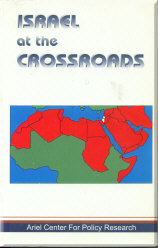|
|
||
| ACPR Research | ||
|
In principle, this study has two major aims:
The Rise in the Potential Strategic Threat 1. Continuing High Level of Arms Purchases in the Middle East The region is still the world’s largest armaments market. Arms imports into the region for the last 5 years were almost $50 billion, which as a proportion of total imports, is 15 times the world average for the same period. Weapons of mass destruction are now part of the expenditures of Israel’s neighbors whose overall pattern has remained fairly constant whatever the broader regional trend 2. Deteriorating Military Balance between Israel and Her Adversaries These ongoing arms purchases have caused important components of the military balance between Israel and her adversaries to shift against Israel's, both quantitatively and qualitatively. This has been due mainly to: The huge acquisition of modern Western weapons by Saudi Arabia (approximately $35 billion worth in the last five years); The shift of the Egyptian army to a Western military doctrine, while equipping itself with high quality American weapons systems, particularly armor and aircraft; The growing cooperation between Syria and Russia, after a period of chilly relations following the break up of the Soviet Union. Between 1984 and 1995, Egypt reduced the quantitative gap in armor between itself and Israel from a ratio of 1:2.06 in favor of Israel to a ratio of 1:1.11. If the Egyptian army's procurement plans are realized, quantitative parity in armor will be reached in the year 2000. In the same years, Egypt radically reduced the qualitative gap in its main battle tank forces relative to those of Israel. In terms of air power, the disturbing erosion of Israel’s qualitative edge was succinctly summed up by Israel’s deputy chief of staff, Gen. Matan Vilna’i, who stated : "What worries me is [the fact] that the Egyptian air force has become a carbon copy of our own air force". 3. The Shape of the Future – New Impending Threats Will Require The Ballistic Threat: An additional factor which presents an increase in the potential threat is the growing proliferation of ballistic missiles in the Mid-East theater. According to some estimates, the Arabs will soon have 2,000 missiles with a ranges of 300 km (Scud B), 550 km (Scud C), as well as 1100 km. Anti-missile systems may prove (as in the Arrow project) very expensive. The Territorial Factor:
The territorial withdrawals implicit in the agreements already signed by Israel, and those designated to be signed by her in the future will impose considerable additional expenditures on Israeli defense, not only to facilitate the physical dismantling and re-deployment of existing systems, but to attempt to compensate for the crucial strategic advantages the present topography provides Israel. Thus while it is difficult to quantify precisely the level of strategic threat confronting Israel, it appears indisputable that this threat is increasing relative to that faced in the past, and likely to do so even more dramatically in the future. The Erosion in Levels of Defense Expenditures Examination of defense expenditures in terms of both absolute value, and as a proportion of her GDP, reveals serious doubts as to the country’s ability to respond adequately to the level of threat facing her. Israel's constant-dollar defense expenditures fell steeply over the ten year period between 1984 and 1994 – by over 70%. As a proportion of the GNP, the decline has been eve steeper, with the relative decrease approaching 300%. 1. Erosion in the Structure of the Defense Budget A change in the priorities within the defense budget. About 50% of the budget is presently spent on salaries, social and fringe benefits, and pensions. This structural shift in the budget – which took place over the last decade – comes at the expense of armament acquisitions and training hours. It is thus mainly the combat units that are hit by this trend. 2. Erosion in the Purchasing Power of the Defense Budget The sharp rise in weapons costs This rise has greatly outstripped the decline in the real purchasing power of the dollar by hundreds of percentage points. According to the cost of weapons (COW) index, the value of American aid has been eroded by nearly 70% (from 1986 to the present). Policy Oriented Aspects 1. The Challenge for the Israeli Leadership The explanation for this seemingly ill-considered policy appears to lie in the tenor of public mood in present-day Israel. In the prevailing climate of unmitigated materialism and almost hedonistic consumerism, it is becoming increasing difficult for elected leaders to allocate resources for purposes which do not produce short terms dividends in terms of tangible improvements in individual and/or public well-being.
2. A Caveat for Israel Leadership Bearing in mind the disastrously disruptive effects of war, efforts to promote economic growth by cutting back on the accumulation of military might are liable not only to be dangerously short-sighted, but disastrously counter-productive. The repeated trauma of a war for which the country is either ill-prepared or unprepared, is liable to shake the very foundations of its society. 3. A Caveat for the US Leadership Given the current trends of inadequate expenditures combined with far-reaching territorial concessions, it is feasible to envisage a scenario in which the US may be called upon to committed troops to active combat in order to prevent Israel suffering military defeat – which as Yigal Allon pointed out "would mean the physical extinction of a large part of its population and the political elimination of the Jewish state". The operational difficulties and expense involved in such an enterprise would be immense, especially as unlike the case of Kuwait, no Arab country would be likely to offer its territory as a staging point for US forces rushing to the aid of the Zionist foe. If on the other, the US decided to forswear her obligation to Israel, the political repercussions are likely to be severe, both domestically and internationally, with the US appearing an unreliable ally. Increased outlays on her own security would significantly reduce the possibility of Israel placing her greatest ally and major source of international support in such an unenviable predicament. Thus it would appear that not only would the Israeli national interest be well served by a considerable boost in defense expenditure, but that of the USA as well. |
||

